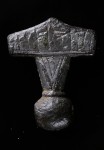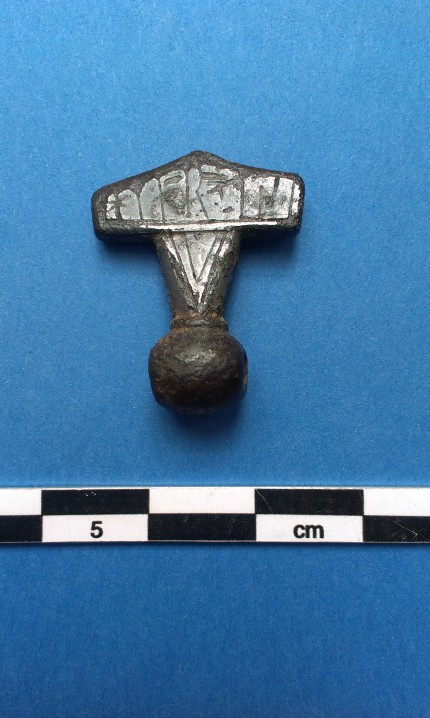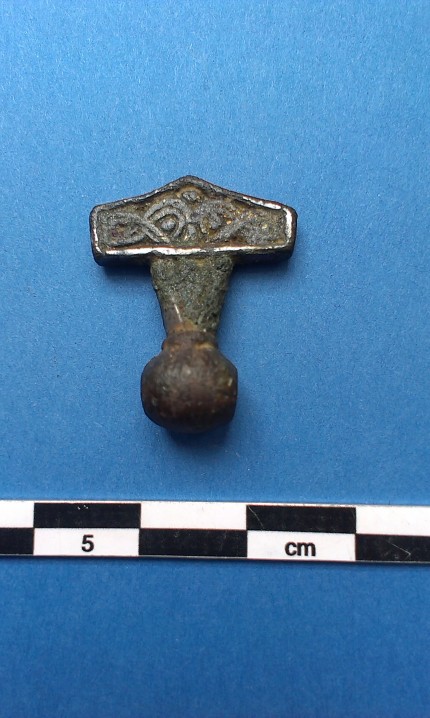 This spring, metal detectorist Torben Christjansen found a small amulet in Købelev on the Danish island of Lolland. Just one inch long and wide, the piece is in a shape known as Thor’s hammer, a design thought to invoke the protective power of Thor and his dwarf-forged hammer Mjolnir. About 1,000 of these Viking-era amulets have been discovered in Scandinavia, the UK, Russia and the Baltic countries, often unearthed in women’s graves. There has been some debate, however, on whether they were representations of Thor’s hammer, even stylized versions. Skeptics point out that the shaft is disproportionately short to be a hammer, and the head too symmetrical.
This spring, metal detectorist Torben Christjansen found a small amulet in Købelev on the Danish island of Lolland. Just one inch long and wide, the piece is in a shape known as Thor’s hammer, a design thought to invoke the protective power of Thor and his dwarf-forged hammer Mjolnir. About 1,000 of these Viking-era amulets have been discovered in Scandinavia, the UK, Russia and the Baltic countries, often unearthed in women’s graves. There has been some debate, however, on whether they were representations of Thor’s hammer, even stylized versions. Skeptics point out that the shaft is disproportionately short to be a hammer, and the head too symmetrical.
Christjansen reported the find as treasure trove to the local Museum Lolland-Falster where curators dated it to the 10th century. The amulet was cast in bronze and has traces of the silver or tin plating and gold plating that once adorned it. One side of the hammer’s head is decorated with interlacing pattern, the other side with a runic inscription seven characters long. This is the first Thor’s hammer amulet ever found inscribed with runes.


Because the runes were so small — three to seven millimeters high — and the surface corroded from the centuries it spent in the ground, the Museum Lolland-Falster curators sent the amulet to the National Museum of Denmark for their experts to decipher. Examining it under a microscope, museum runologist Lisbeth Imer was able to translate the inscription and it resolves the hammer question in the bluntest terms possible: the runes read “Hmar is x,” or in modern Danish “Hammer is” (the x isn’t a letter but a delimiter between two words). Translated into English the inscription simply says “This is a hammer.”
 There are two mistakes in the runes. The author left out the first a in “hammer” and flipped the S-rune backwards à la Toys-R-Us. These could have been errors of literacy or a function of the tiny space the writer had to inscribe. Even if his or her spelling was spotty, the rune carver would have derived status and prestige from being literate in a society that prized writing.
There are two mistakes in the runes. The author left out the first a in “hammer” and flipped the S-rune backwards à la Toys-R-Us. These could have been errors of literacy or a function of the tiny space the writer had to inscribe. Even if his or her spelling was spotty, the rune carver would have derived status and prestige from being literate in a society that prized writing.
The hammer wasn’t the only artifact Christjansen found on the site. He discovered pieces of silver needles and a matrix used to make brooches. These finds could indicate there was a jewelry-making workshop in the area. If so, the hammer could have been made locally. There are no plans currently for an archaeological investigation of the site. Christjansen will keep surveying the area with his metal detector, however, and Museum Lolland-Falster curators will be working with him going forward.
My best find ever
Best regards from a very happy Man :yes:
Forgot too sign my name and email
still happy hope to make more finds on the location :boogie:
Torben…Since the Thor hammer has no personal name or dedication to a name, could it be a makers sample. Since it might be from a metal making or fabricating site or workshop it could be a “makers sample” and therefore left name-less, but an impressive and exceptional find nonetheless. The Runes might just show “where” a future owners name could be placed if an order was made. Business was business, even in those less sophisticated days of the 10th. Cent. as the Viking era was all about trade!
Congratulations on a very important and exciting find – and I hope that there will be others! Ed G.
Thanks Edward I will inform you about my future finds on the location
Thanks for your comments Byron
:yes: This made my day! This work is inspiring. “This is a Hammer!” Thank you for all your hard work! What an amazing line of work.
Robert Taylor (Moscow, Idaho)
Thorbjørn findør Mjølner :boogie:
I wonder if there exists a Magritte version: “This is not a hammer.”
In my opinion the runes are cleverly calculated and composed. The rune R is quite deliberately placed in the center, the biggest in size. It refers to Thor, whose “ride” through the skies causes the thunder while the hammer, Mjölnir, produces the thunderbolt. This charm seems to be supported by rune names, numbers and value. If so it would rank among the most significant finds of the pagan past.
For more see: http://www.franks-casket.de/english/appendix11.html
As for the picture I would like your permission to use it for that article.
Long may the runes exist! This is a fine discovery.
DId any one pick up this hammer?
I’m making a silver copy of this pendant 🙂
Cool! I’d love to see a picture of it when you’re done.
Send me your mail and I will send you the photos of it during my job in wax 🙂
My mail is znojmo4 at yahoo dot it
The Hammer is ready. If someone wants to see it, I can send the pics, but I need the email address 🙂
Lory, you are a genius. There’s no other word for it. The amulet is perfection.
I’d want to put some pics here but I’m not able to do it.
If you upload them to the web you can embed them in a comment using the html img tags, at least I think so. But I have a better idea that I’ll email you about right now.
Livius, maybe you can do it because you’ve the pics too. I’m not able with uploading pics 🙂 Yes, I need your help.
Thank you very much Livius 🙂
has anyone or company made a replica of this?
Hello Mr. Torben : :thanks:
Is there any way to have a private conversation with you regarding your finding ?
:boogie:
I was looking for an unique hammer pendant for my own 1:1 battle capable design of Mjolnir.
This is what I was looking for 😀